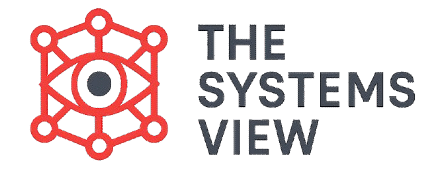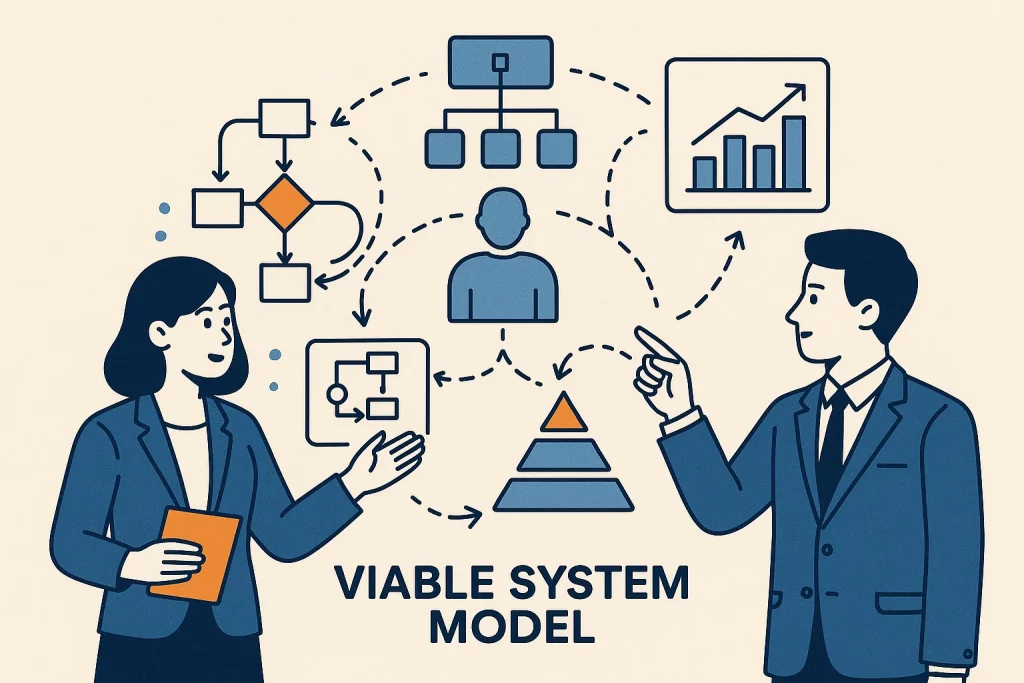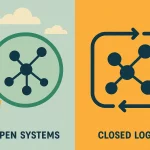If you could design a perfect organization, what would it look like? It would be a system that survives any change in the market, resists chaos, and adapts forever. It would look like you.
The Viable System Model (VSM) is a revolutionary organizational chart. It is based not on finance or hierarchy, but on biology. It is the ultimate expression of Cybernetics applied to management. British cybernetician Stafford Beer developed the VSM. It is a blueprint for any system that needs to be viable. This means a company, a government, or a team must be able to adapt and survive in a constantly changing environment.
Beer’s genius was realizing that the human body is the most successful, viable system on Earth. The VSM is his detailed model of the five necessary functions. These five functions are the “nervous system” that allows an organism or an organization to remain alive.
What is the Viable System Model?
The core principle of the VSM is viability. A system is viable if it can respond to environmental challenges and maintain its existence. Beer found that any successful system must manage an immense amount of complexity. This complex challenge is called variety.
The Law of Requisite Variety in VSM
As we learned earlier, the Law of Requisite Variety states that a controller must be as complex as the system it controls. A large company faces huge variety. This variety comes from customers, competitors, and new technology. If its management structure is too simple, the company will fail to control this variety and collapse.
The VSM solves this problem by being recursively designed. This means the entire model works at every level. A company is a viable system, and every department within that company is also a viable system. Each part contains the same five essential functions. This structure allows the VSM to manage complexity at every scale.
The Five Interlocking Systems (VSM 1-5)
Stafford Beer broke down the functions necessary for viability into five distinct, essential systems. All of these systems are linked by communication channels.
System 1: The Operations (Do it)
This is the part of the organization that deals directly with the outside world. It provides the primary service or product. Think of this as the hands, muscles, and organs of the body. System 1 is where money is made and variety is absorbed. This includes the factory floor, the sales teams, and the call center.
System 2: Coordination (Keep it Smooth)
This system exists purely to stop System 1 units from interfering with each other. It smooths out conflicts and handles scheduling, standards, and shared services. It is like the basic nervous system that regulates heartbeat and breathing. System 2 stops oscillations and friction. Examples include scheduling meetings, shared IT, or standard operating procedures.
System 3: Management (Make it Work)
This is the core, high-level management function. It looks inward, making sure that Systems 1 and 2 are running efficiently. It allocates resources, audits performance, and sets internal priorities. This is like the brain stem and lower executive functions. System 3 maximizes the effectiveness of the current operations.
System 4: Intelligence (Look Outside)
This is the dedicated intelligence unit. It looks outward to the future and the environment. It conducts research, forecasts trends, and monitors competitors. It asks: “What will happen next year?” This is like the sensory organs (eyes, ears) and the cortex, which plans for the future. System 4 ensures the organization is ready to change.
System 5: Policy (Set the Course)
This is the identity and ultimate authority of the organization. System 5 sets the values, defines the organization’s purpose, and maintains the overall balance. It balances the internal focus of System 3 and the external focus of System 4. This is like the frontal lobe, self-consciousness, and identity. System 5 maintains the organization’s integrity and core mission.
Communication: The Nervous System of the VSM
The VSM is defined by its channels of communication. These are all feedback loops flowing up and down the structure. Beer identified specific pathways for efficiency.
The Algedonic Loop
For the VSM to be effective, minor problems should be fixed locally in System 1. Only severe problems should escalate upward to Systems 3 and 5. Beer created the Algedonic Loop. This name comes from the Greek words for pain, algos, and pleasure, hedone.
The Algedonic Loop is a communication channel. It bypasses lower management when a crisis (pain) or a massive opportunity (pleasure) requires immediate attention from the highest policy level. This is like touching a hot stove. Your hand retracts before your brain fully processes the pain.
Variety Engineering
To manage the flow of complexity across the channels, the VSM uses variety engineering.
- Attenuators: These mechanisms reduce the complexity coming into the organization. An example is a standard form that forces varied customer requests into simple categories.
- Amplifiers: These mechanisms boost the organization’s complexity when responding to the environment. An example is a simple command from the CEO that is amplified into a massive, organized effort by the System 3 managers.
The Viable System Model provides a perfect, non-hierarchical structure for any enterprise. It demands that the capacity to sense and respond to a problem (requisite variety) must be maintained at every level, ensuring the entire system can adapt, rather than simply collapse from uncontrolled complexity.
Conclusion
The Viable System Model (VSM), developed by Stafford Beer, is the ultimate Cybernetic framework for organizational design. It models the necessary functions for survival on the human nervous system. By defining five interlocking systems (VSM 1-5) and mandating precise feedback channels like the Algedonic Loop, the VSM ensures that complexity and variety are managed effectively at every level. The VSM is not just an organizational chart. It is a theory of life that provides the blueprint for any system seeking true, adaptive viability in a chaotic world.



